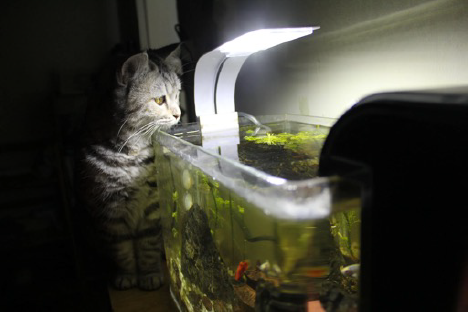 Photo by Thanh Hoang from Pexels
Photo by Thanh Hoang from PexelsImagine this: a serene underwater world, alive with the gentle sway of aquatic plants and the graceful dance of colorful fish. Now, add a curious feline, its eyes wide with wonder, paws pressed against the glass, utterly mesmerized by this moving mosaic of life. This isn't just a peaceful coexistence; it's a captivating ballet between two vastly different creatures - the enigmatic cat and the tranquil inhabitants of an aquarium. As these two worlds collide, a unique bond forms, one that's as enchanting as it is unexpected.
Understanding Feline Behavior Around Aquariums
Cats exhibit a deep-rooted curiosity and a strong hunting instinct, traits that play a significant role in their interaction with aquariums. These inherent characteristics are key to understanding how cats behave around fish tanks and their aquatic inhabitants.
- Innate Curiosity: The exploratory nature of cats turns their environment into a continuous adventure. An aquarium, bustling with movement and rich in visual stimuli, naturally draws a cat's attention. The motion of the fish, the gentle sounds of water, and the changing light patterns within the tank are all aspects that can keep a cat fascinated for extended periods.
- Predatory Instincts: These instincts are an essential part of a cat's makeup. The sight of fish darting around in water can activate a cat's instinct to hunt. This reaction is instinctual and not driven by hostility. The movements of the fish can prompt various behaviors in cats, ranging from light pawing at the tank to more intense stalking actions.
Choosing the Right Aquarium
 Photo by Mart Production from Pexels
Photo by Mart Production from PexelsSelecting the appropriate aquarium is a crucial step in ensuring a safe and harmonious environment for both your cat and your aquatic pets.
- Sturdy and Secure: Choose an aquarium that is sturdy and well-balanced to prevent tipping or wobbling. A heavy base or a secure stand can provide additional stability, especially important in homes with active or larger cats.
- Size Matters: Larger tanks are generally heavier and less likely to be knocked over. However, consider the available space and the type of fish you plan to keep.
- The Lid is Essential: A secure lid is non-negotiable. It should fit snugly to prevent curious paws from fishing or falling in. Ensure the lid allows for proper ventilation while being secure enough to keep your cat out.
- Location, Location, Location: Place the aquarium in a spot that's less accessible to your cat. Elevated surfaces or rooms that can be closed off might be ideal. The location should also allow for easy viewing, satisfying your cat's curiosity without endangering the fish. It should also be away from direct heat sources to keep fish safe and comfortable.
- Glass vs. Acrylic: Acrylic tanks are lighter and less prone to cracking but can scratch more easily. Glass tanks are heavier and more scratch-resistant, offering better protection against curious claws.
Training Your Pets
Successfully training your pets to coexist peacefully involves patience, consistency, and a few strategic practices. The goal is to satisfy their curiosity and hunting instincts in a non-disruptive manner. Here's how to achieve this:
- Gradual Introduction: Start by allowing your cat to observe the aquarium from a distance. Gradually let them get closer under supervision. This helps them get used to the presence of the tank without immediately engaging with it and may prevent aggressive behavior.
- Use of Deterrents: Consider using mild deterrents to discourage your cat from getting too close. Double-sided tape or a motion-activated air spray near the aquarium can be effective. These deterrents should be safe and not cause fear or stress.
- Positive Reinforcement: Reward your cat for calm behavior around the aquarium. Treats, affection, or playtime can reinforce good behavior. It goes beyond improving the human-animal bond. This helps your cat associate the aquarium with positive experiences.
- Provide Alternatives: Offer other forms of entertainment like toys, window perches, or interactive cat trees. This can help divert their attention from the aquarium.
- Feeding Schedule for Fish: Interestingly, betta fish can go without eating for a period, allowing for a more flexible feeding schedule. This can be advantageous in reducing the frequency of opening the tank, a time when cats are often most tempted to interfere.
- Never Punish: Avoid using punishment as a training method. This can lead to fear and anxiety, which may exacerbate unwanted behavior.
Wrapping Up
Introducing cats to aquariums can be a delightful experience if approached with understanding and care. By considering your cat's natural behaviors, choosing the right aquarium, implementing effective training, and creating a safe environment, you can foster a harmonious coexistence that brings joy and fascination to both your feline and aquatic friends.
References
- Wilson, E.K., Stratton, R.B., Bolwell, C.F., Stafford, K.J., Comparison of Positive Reinforcement Training in Cats, Journal of Veterinary Behavior
- British Psychological Society